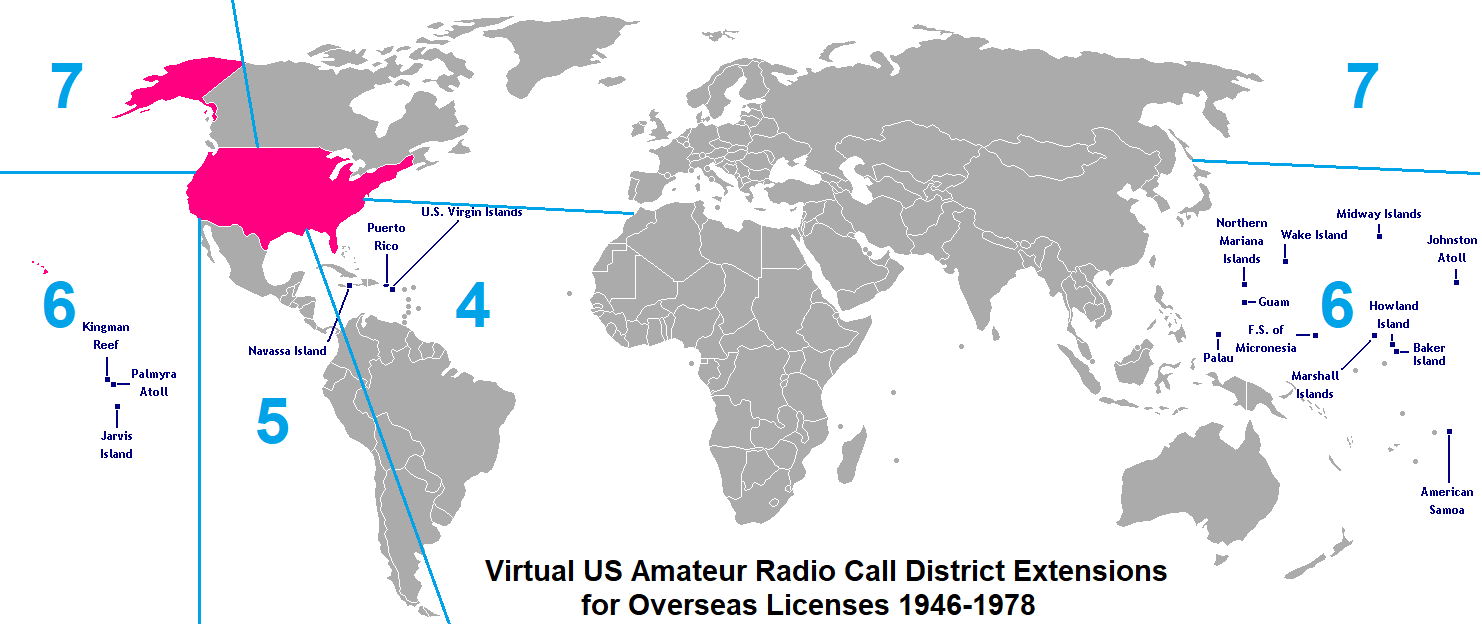|
||||||||||||||||||||||||||||||||||||||||||||||||||||||||||||||||||||||||||||||||||||||||||||||||||||||||||||||||||||||||||||||||||||||||||||||||||||||||||||||||||||||||||||||||||||||||||||||||||||||||||||||||||||||||||||||||||||||||||||||||||||||||||||||||||||||||||||||||||||||||||||||||||||||||||||||||||||||||||||||||||||||||||||||||||||||||||||||||||||||||||||||||||||||||||||||||||||||||||||||||||||||||||||||||||||||||||||||||||||||||||||||||||||||||||||||||||||||||||||||||||||||||||||||||||||||||||||||||||||||||||||||||||||||
INTRODUCTIONThe issue of amateur radio callsigns that do not correspond with geographic location exists with some United States overseas territorial callsigns and also on a larger scale within the United States since March 24, 1978 when the Federal Communications Commission (FCC) through Docket 21135 deleted Part �97.53 permitting licensees to retain their callsign regardless of wherever they move within the U.S., and since 1996 when the FCC adopted PR Docket 93-305 permitting vanity callsigns1 with any requested call district number. In fact approximately 12% of all United States amateur radio operators have call signs that do not reflect the district in which they reside.2 This situation requires diligence in confirming the actual location of a station for contests and operating awards such as Worked All States and DX Century Club.3 HISTORY OF U.S. TERRITORIAL CALLSIGNSCallsigns prior to 1946Prior to 1927, amateur radio callsigns consisted of a call district number and two letters. After the 1927 International Radiotelegraph Conference assigned prefixes K, N and W to the United States, the U.S. Department of Commerce issued the callsign prefix W to stations in the continental U.S., and the prefix K to the overseas territories. The prefix N was reserved for the U.S. Navy.4 Callsigns 1946 to 1978Upon the postwar reopening of the amateur radio service in 1946, the FCC foresaw the coming exhaustion of W prefix callsigns and decided to assign both W and K prefixes to continental U.S. radio amateurs. They then reserved distinctive two letter callsign prefixes for the overseas territories. The Caribbean island territories like Puerto Rico KP4 and Virgin Islands KV4 were assigned two letter prefixes with the number "4", considering them to be offshore extensions of the 4th mainland call area. For this same reason, the Panama Canal Zone was assigned KZ5, Hawaii was KH6 and Alaska was KL7.5 
The U.S. territorial prefixes in effect from 1946 through 1978 were: KB6 Baker, Howland & American Phoenix Is,; KC6 Caroline Is.; KG6 Guam & Mariana Is.; KH6 Hawaii; KJ6 Johnston; KL7 Alaska; KM6 Midway; KP4 Puerto Rico; KP6 Palmyra Group & Jarvis; KS4 Swan Is.; KS6 American Samoa; KV4 Virgin Is,; KW6 Wake Is.; KX6 Marshall Is.; and KZ5 Panama Canal Zone. KC4 was reserved for both Navassa Is. and U.S. stations in Antarctica, KA0-KA9 for U.S. military personnel in Japan, KG4 for U.S. military personnel at Guantanamo, and KR6 for U.S. military personnel in Okinawa and the Ryukyu Islands. Novice class territorial callsigns were distinguished by an initial prefix letter "W" that was replaced by a "K" upon upgrading. Typical Novice class station callsigns would be WG6ABC in Guam or WP4ABC in Puerto Rico.6 Special 1976 U.S. Bicentennial Celebration CallsignsDuring the 1976 calendar year, the FCC permitted the use of special U.S. Bicentennial Celebration prefixes on a voluntary basis with no required special approval. The authorized prefixes for continental U.S. radio amateurs were simple, but some territorial licenses required shuffling of letters and numbers.7 The U.S. Army and Air Force commonly used callsign prefixes beginning with the letter "A", but prior to this the FCC had never issued such prefixes to radio amateurs.
b Guam only, NOT the other Mariana Is. c Novices on Baker, Canton, Enderbury, Howland Is., NOT California (other "W" prefixes in this table are also Novice stations.) Callsigns since 1978In March 1978, the FCC completely restructured systematic assignment of amateur radio callsigns and changed most overseas amateur radio prefixes. All Caribbean island territories were assigned KP, NP and WP prefixes, and the Pacific island territories were assigned AH, KH, NH and WH prefixes.8 By that time the Caroline Islands (Micronesia and Palau), Marshall Islands, Ryukyu Islands and Swan Is. were no longer under U.S. administration. Call signs in the KC4AAA-KC4AAF and KC4USA-KC4USZ blocks continue to be reserved for Antarctic stations. Other call sign blocks reserved for FEMA and overseas U.S. Military personnel are listed in the November 12, 2009 ARRL Letter.9 AMATEUR RADIO LICENSES IN ALASKA, HAWAII AND US OVERSEAS TERRITORIES (FCC ULS Data from 31 July 2015)10
AMATEUR RADIO CALLSIGN PREFIXES RESERVED FOR US OVERSEAS TERRITORIESThe Federal Communications Commission assigns amateur radio callsigns with the following prefixes exclusively to amateur radio stations with a mailing address in the corresponding overseas territory pursuant to FCC Part �97.19(d)(4) which states:
Since the establishment of the Novice class license in 1951 until 1978, Novices in overseas US territories were assigned a corresponding callsign prefix with the initial letter "W." Exceptions: U.S. Overseas Territories Callsigns in the Continental United StatesAlthough the FCC assigns U.S. overseas territorial callsigns exclusively to applicants with mailing addresses in those territories and such callsigns are not available under the Vanity callsign program to licensees in the continental United States (CONUS), a significant number of CONUS licensees do operate with such callsigns. Radio amateurs licensed in overseas U.S. entities may retain their callsigns when relocating to the continental United States or to any other U.S. overseas entities. In addition, a few CONUS licensees have circumvented the FCC restriction by establishing a temporary mail drop in an overseas territory solely for the purpose of obtaining an overseas callsign with no intent of ever operating a station in that territory, such as the case of the Alaskan callsign AL0HA currently held by the Coconut Island DX Association in Hilo, Hawaii. These exceptions may confuse radio amateurs who seek contacts with Alaska, Hawaii and U.S. overseas territories for their award or contest credit as DX entities separate from the continental United States and, for that reason, require extra diligence. TERRITORIAL CALLSIGNS REGISTERED WITHIN TEN POPULOUS CONTINENTAL UNITED STATES (FCC ULS Data from 31 July 2015)10This is a count of Alaska, Hawaii, and Puerto Rico
"expatriate" callsigns with current addresses registered
within ten of the most populous continental United
States.
|
||||||||||||||||||||||||||||||||||||||||||||||||||||||||||||||||||||||||||||||||||||||||||||||||||||||||||||||||||||||||||||||||||||||||||||||||||||||||||||||||||||||||||||||||||||||||||||||||||||||||||||||||||||||||||||||||||||||||||||||||||||||||||||||||||||||||||||||||||||||||||||||||||||||||||||||||||||||||||||||||||||||||||||||||||||||||||||||||||||||||||||||||||||||||||||||||||||||||||||||||||||||||||||||||||||||||||||||||||||||||||||||||||||||||||||||||||||||||||||||||||||||||||||||||||||||||||||||||||||||||||||||||||||||
REFERENCES
|
||||||||||||||||||||||||||||||||||||||||||||||||||||||||||||||||||||||||||||||||||||||||||||||||||||||||||||||||||||||||||||||||||||||||||||||||||||||||||||||||||||||||||||||||||||||||||||||||||||||||||||||||||||||||||||||||||||||||||||||||||||||||||||||||||||||||||||||||||||||||||||||||||||||||||||||||||||||||||||||||||||||||||||||||||||||||||||||||||||||||||||||||||||||||||||||||||||||||||||||||||||||||||||||||||||||||||||||||||||||||||||||||||||||||||||||||||||||||||||||||||||||||||||||||||||||||||||||||||||||||||||||||||||||
 U.S. Overseas
Territories Amateur Radio License Data
U.S. Overseas
Territories Amateur Radio License Data